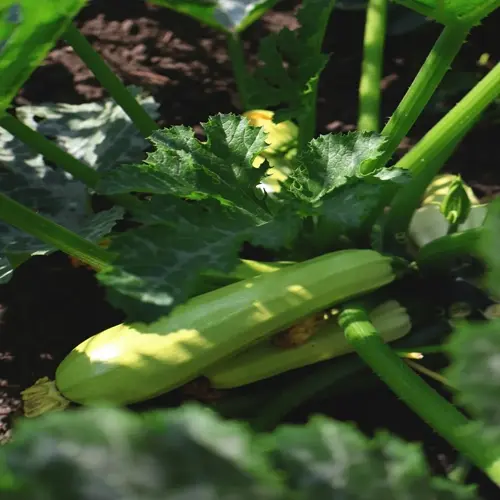12 Vertical Gardening Herbs You Can't Miss

Written by
Olivia Mitchell
Reviewed by
Prof. Samuel Fitzgerald, Ph.D.Herbs for vertical gardening allow you to use the available space efficiently through structures, like modular systems or DIY pallet systems.
Basil, mint, and chives are reliable herbs for beginners who are starting a vertical garden.
Proper drainage is essential; make sure to have a layer of gravel at the bottom and holes in multiple locations of the container so that it can drain at a faster rate.
Base your vertical vegetable or herb garden south-facing for maximum exposure opportunities, so that supplements extend to the leaves of the herbs.
You should water herbs early mornings with drip irrigation system for 90% efficient watering.
Examples of 12 top essential vertical gardening herbs include rosemary, thyme, lavender, and cilantro.
Article Navigation
Beginning with vertical gardening herbs effectively solves the challenge of small spaces in a flat or small home. Imagine picking fresh basil for dinner without having to step outside. You keep fresh flavors just an arm's length away every day. This method maximizes every inch of space you live in.
Vertical gardening transforms dull balconies into seed-green paradises. Imagine walls covered with cascading mint, basil, or thyme. Improved air circulation minimizes the chance of mildew forming. Fewer pests invade than in the case of plants in the ground, and your herbs grow healthier and with more vigor.
Choosing Your Vertical Structure
Choosing an appropriate vertical structure turns your herb garden dream into reality. Modular systems are a perfect plug-and-play solution for balcony gardeners. Do-it-yourself pallet projects bring budget-sized creativity to ground spaces. Weight limits should be considered carefully, especially in cases involving elevated installations.
Effective drainage features are crucial for the success of vertical herbs. Modular systems with built-in reservoirs help maintain optimal moisture levels. Fabric liners will prevent soil loss in pallet projects. Magnetic tins may require modifications to the drain hole to promote root health.
Paired to your conditions for durability include: Galvanized steel suitable for coastal humidity will not rust; pressure-treated wood for rainy areas is designed to last for years; and UV-stabilized plastics can endure harsh sunlight without cracking.
Installation time varies drastically between options. Modular systems snap together in under an hour. Pallet projects require weekend construction efforts. Hanging organizers install instantly using existing hooks.
Your vertical garden should meet your needs. Renters enjoy tension rod shelves that don't require permanent modifications; urban balconies can utilize wall-mounted magnetic tins to save space; and large patios can incorporate substantial pallet garden installations.
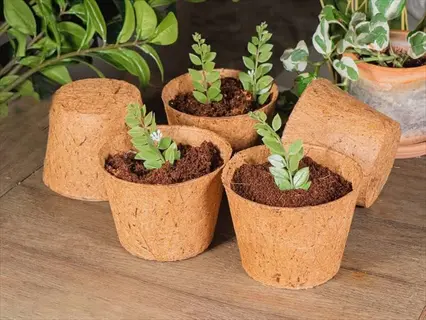
Coco Coir Pots
- Water Retention: Holds moisture longer than plastic alternatives for reduced watering frequency
- Root Health: Natural air pruning prevents circling roots and promotes dense growth
- Durability: Withstands outdoor conditions for multiple growing seasons without degradation
- Eco Impact: Biodegradable material supports sustainable gardening practices
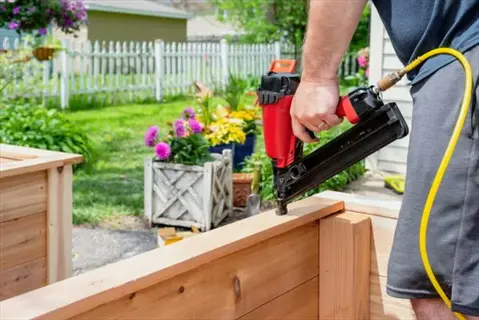
Pressure-Treated Wood
- Weather Resistance: Protects against moisture damage in rainy climates for long-term use
- Longevity: Maintains structural integrity for years with minimal maintenance required
- Safety: Modern treatments ensure non-toxic composition suitable for edible plants
- Installation: Requires pre-drilling pilot holes to prevent wood splitting during assembly
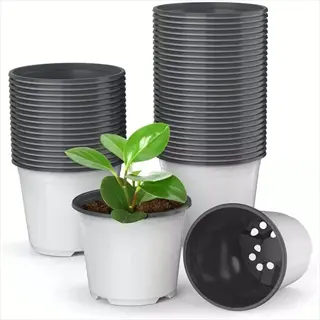
UV-Stabilized Plastic
- Sun Protection: Prevents cracking and fading when placed in direct sunlight locations
- Weight: Light enough for hanging installations without structural reinforcements
- Cleaning: Smooth surfaces allow quick sanitization between planting cycles
- Cost: Higher investment pays off through extended lifespan and reduced replacements
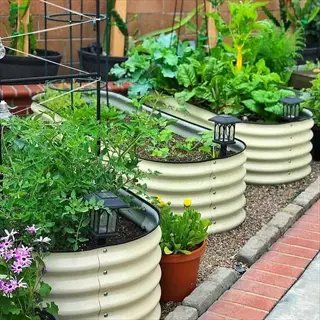
Galvanized Steel
- Rust Prevention: Zinc coating prevents corrosion in humid coastal environments
- Heat Reflection: Metallic surface deflects excess warmth from delicate herb roots
- Modularity: Interlocking panels enable custom sizing for irregular wall spaces
- Drainage: Pre-punched holes allow water escape without additional modifications

Bamboo Frames
- Sustainability: Rapidly renewable resource with minimal environmental footprint
- Flexibility: Can be curved to create spiral or arch designs for visual interest
- Weight Support: Strong enough to hold trailing herbs like mint or thyme
- Installation: Lightweight structure requires only basic wall anchors for mounting
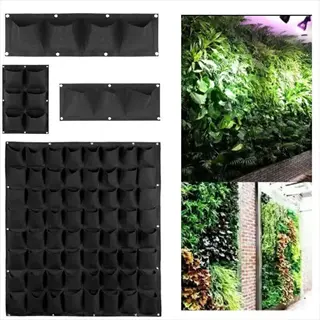
Recycled Fabric
- Breathability: Allows air circulation to prevent root rot in dense plantings
- Portability: Rolls up compactly for seasonal storage or renter relocation
- Water Distribution: Even moisture dispersion through capillary action principles
- Compatibility: Works with drip irrigation systems for automated watering setups

Terra-Cotta
- Moisture Control: Porous walls absorb excess water to prevent herb root suffocation
- Temperature Stability: Insulates roots against rapid temperature fluctuations
- Aesthetics: Classic look complements both modern and traditional garden styles
- Durability: Thick-walled versions withstand freeze-thaw cycles in cold zones

Polypropylene Mesh
- Drainage Speed: Fast-draining material prevents waterlogging in rainy seasons
- Ventilation: Open weave structure promotes air pruning for healthier herb roots
- Flexibility: Can be shaped into towers or wall panels for creative layouts
- Weight: Ultra-light material allows installation on fragile surfaces like drywall

Cedar Wood
- Natural Resistance: Contains oils that repel insects and resist fungal decay
- Longevity: Maintains appearance for 7-10 years without chemical treatments
- Aroma: Pleasant scent enhances the gardening experience near seating areas
- Insulation: Protects herb roots from both summer heat and winter chill
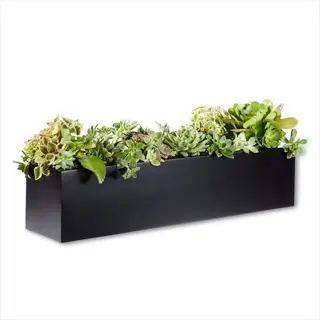
Fiberglass Troughs
- Weatherproof: Impervious to UV damage, freezing temperatures, and heavy rain
- Color Options: Available in finishes that mimic wood or stone aesthetics
- Low Maintenance: Requires only occasional wiping to maintain appearance
- Installation: Pre-formed brackets allow secure mounting on railings or walls
Sunlight and Placement Essentials
Herbs require specific hours of sunlight to flourish in a vertical position. Basil needs 6 hours of direct sunshine. Mint can go by with four. Rosemary requires eight hours of daylight to grow well. Place your vertical garden toward the south in northern areas. Shift the approach of your garden every season as the sun goes higher in the sky.
At every 10° of latitude, there is a big change in the seasonal path of the sun. At 40°N, the sun is low in the south during winter, resulting in a short exposure time to sunlight, and high in the sky during summer, resulting in a longer exposure time to sunlight. Use free solar calculator apps. Rotate the planters monthly to ensure even sunlight distribution.
Reflective materials enhance light efficiency in various ways. Anodized aluminum panels reflect 85% of light. Mirrors typically create hotspots, which require careful placement. Light tunnels made of polycarbonate will produce a gentle diffused beam of light. Selecting lighting materials that will work well for your specific space and budget is important in any lighting design.
Indoor vertical gardens need LED grow lights. Use 4000K-6000K full-spectrum bulbs for leafy herbs. Place 12 inches above plants. Timers should cycle lights 14 hours per day. The systems use 60% less energy than fluorescents.
Summer Positioning
- Place vertical gardens facing south in Northern Hemisphere locations
- Use shade cloth during peak afternoon hours to prevent leaf scorch
- Elevate planters 12 inches (30 cm) for improved air circulation
Winter Adjustments
- Relocate to west-facing walls for afternoon warmth exposure
- Angle planters 15° toward low winter sun for maximum absorption
- Group containers together to create microclimate heat retention
Spring/Fall Transition
- Rotate planters weekly for even light distribution on all sides
- Monitor sunrise/sunset times using gardening apps for optimal placement
- Combine with deciduous trees for natural seasonal shading
Coastal Climate Adaptation
- Position gardens perpendicular to prevailing ocean breezes
- Use salt-resistant reflective barriers to protect herbs
- Increase sun exposure by 20% to compensate for marine layer fog
Desert Climate Solutions
- Install morning sun exposure with afternoon shade structures
- Use double-layered shade cloth to reduce light intensity by 40%
- Place water-filled containers nearby for evaporative cooling effect
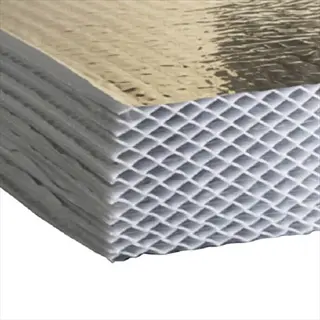
Reflective Panels
- Material: Anodized aluminum sheets with 85% light reflectivity
- Placement: Position at 45° angles to target lower herb tiers
- Benefit: Increases usable light by up to 40% in shaded corners
- Installation: Secure with UV-resistant adhesive strips

LED Grow Lights
- Spectrum: Full-spectrum 4000K-6000K for vegetative growth
- Coverage: 24W lights cover 4 sq ft (0.37 m²) at 12-inch height
- Timing: 14 hours daily with automatic timer systems
- Energy: Uses 60% less power than fluorescent alternatives

Light Tunnels
- Design: Polycarbonate tubes directing sunlight downward
- Effectiveness: Transmits 70% ambient light to lower levels
- Best For: Narrow urban spaces between tall buildings
- Maintenance: Monthly cleaning prevents dust accumulation
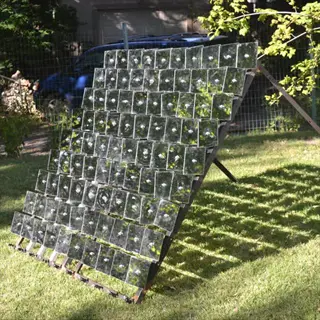
Mirror Arrays
- Configuration: Angled safety-glass mirrors in grid patterns
- Caution: Avoid hot-spot creation that could burn leaves
- Adjustment: Reposition seasonally to track sun movement
- Safety: Use shatter-resistant film for balcony installations

Light-Diffusing Films
- Material: Polyethylene sheets with prismatic texture
- Function: Spreads light evenly across vertical surfaces
- Durability: UV-stabilized for 5+ year outdoor lifespan
- Application: Adheres directly to walls behind planters
Solar Tracking Systems
- Mechanism: Automated rotation follows sun path throughout day
- Efficiency: Boosts light exposure by 25% compared to fixed systems
- Power: Operates on rechargeable batteries or small solar panels
- Setup: Requires mounting on swivel base with light sensor
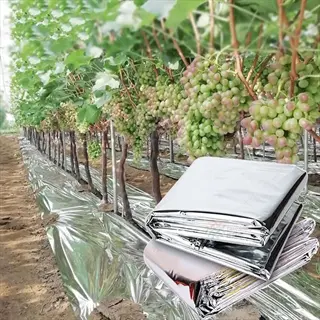
Light-Reflective Mulch
- Composition: Metallic polyethylene sheeting with diamond pattern
- Function: Redirects ground-level light to lower herb leaves
- Benefit: Increases photosynthesis in shaded plant sections
- Installation: Lay beneath vertical garden structure as base layer

Prismatic Glass Panels
- Optics: Angled facets distribute light without hot spots
- Transmission: Delivers 80% of ambient light to plant surfaces
- Durability: Tempered glass withstands hail and high winds
- Mounting: Frame system attaches to existing garden structures

Fiber Optic Plant Lighting
- Technology: Bundled fibers channel sunlight indoors
- Range: Covers up to 20 sq ft (1.86 m²) per collector unit
- Intensity: Provides equivalent of 4 hours direct sunlight
- Placement: Terminals positionable at different garden heights

Retractable Shade Systems
- Function: Adjustable coverage for light-sensitive herbs
- Control: Manual crank or motorized options available
- Material: UV-blocking fabric with 50-80% light reduction
- Timing: Use during midday heat to prevent herb wilting
Soil and Drainage Requirements
The type of soil material used indicates the health of herbs for use in vertical gardens. Coco coir retains its moisture more than does peat moss without compacting. It retains water longer and thus has a longer time between waterings. Peat moss acidifies the soil; therefore, adjustments in pH are necessary. Both require supplementary perlite to remain properly aerated.
The size of perlite particles directly affects root health. Coarse perlite creates air spaces that allow oxygen to flow. Suppose fine grades are used; the compact quickly limits drainage. For best results, the size of the particles should be an inch, preventing the danger of water, but affording the soft, delicate roots of the herbs the needed support.
Superficial-rooted herbs require precision in the depth of the soil. Mint will thrive in six-inch pots, and basil needs eight. Measure the depth of the container from the root crown to the bottom of the post. Allow an extra two inches for mature growth. Be careful to provide a depth of soil for the size of the flowering plant in containers.
A layer of gravel protects against drainage catastrophes. Use 1" gravel at the base of containers. For small planters, use pea gravel; for larger ones, use crushed rock. This barrier prevents the soil from filling the holes. Add landscape fabric above the gravel for added protection.
Reservoir Systems
- Built-in water tanks maintain consistent moisture levels
- Wicking fabric draws water upward to herb roots as needed
- Refill indicator shows when reservoirs need replenishment
Gravel Layering
- 1-inch (2.5 cm) gravel base at container bottom
- Separates soil from drainage holes to prevent clogging
- Use pea gravel for small pots, crushed stone for large planters
Drainage Hole Optimization
- Minimum 4 holes per square foot (0.1 m²) of soil surface
- 0.25-inch (6 mm) diameter holes prevent waterlogging
- Elevate pots 0.5 inches (1.3 cm) above drip trays
Soil Amendment Schedule
- Replace 30% topsoil every 3 months with fresh compost
- Add mycorrhizal fungi during replanting for root health
- Test pH monthly (ideal: 6.0-7.0 for most herbs)
Sloped Planters
- 5° downward angle directs water to drainage points
- Prevents water pooling at herb root crowns
- Use adjustable feet for balcony installations
Watering Techniques Simplified
Correctly determining soil moisture prevents poor watering decisions. The finger test consists of feeling for dryness of the surface soil to the first knuckle. Moisture meters indicate moisture content, but they need to be weekly calibrated. Both tests work well if applied consistently before watering takes place.
Deep watering greatly strengthens the roots of herbs. Water until water drains from the bottom of the containers. This encourages downward root growth as the plant seeks moisture. Strong roots allow plants to anchor themselves in vertical situations better, and they can also absorb nutrients from the deeper layers of the soil mix.
Drip irrigation timers automate watering. Set systems to operate in the early morning hours before 8:00 A.M. Program in 5-minute sessions every day during the warm summer months. In cooler months use 15-minute sessions every other day. Battery powered models can be used where there is no outdoor electrical outlet available.
Identify signs of overwatering across herb types. Basil has yellow leaves starting at the bottom. Mint has black stems low on the plant. Rosemary needles turn brown and brittle. Woody herbs, like thyme, have mushy roots when overwatered.
Summer Strategy
- Water before 8 AM to prevent midday evaporation losses
- Increase frequency by 30% during heat waves above 90°F (32°C)
- Add mulch layer to retain soil moisture
Winter Approach
- Reduce watering to once weekly for indoor herbs
- Use room-temperature water to avoid root shock
- Check soil moisture only after top 2 inches dry out
Spring/Fall Routine
- Transition gradually between summer/winter schedules
- Monitor rainfall with built-in weather apps
- Adjust based on humidity levels: reduce in high humidity
Windy Conditions
- Increase watering by 20% on windy days
- Use windbreaks to reduce evaporation
- Check soil moisture twice daily
High Humidity
- Decrease watering frequency by 25%
- Improve air circulation with small fans
- Watch for fungal signs on herb leaves
Top Herbs for Vertical Gardens
Root depth is the indicator of herb success in vertical systems. For example, chives are classified as shallow-rooted herbs and can thrive in a 4-inch container. In contrast, rosemary is an 8-inch rooted herb, and needs a deeper growing container. Match each herb's container depth to its natural vertical root growth pattern for successful herb development.
Herbs can have significantly different sun requirements. Mediterranean herbs, for example, require all-day sun. Leafy herbs like basil can handle some shade in the afternoons. Therefore, it is best to place the full-sun herbs near the top of vertical supports to receive the most sun possible.
Routine pruning encourages compact growth in containers. Pinch back the tips of basil weekly to discourage flowering. To develop bushiness, cut stems of mint just above the leaf nodes. Prune woody herbs conservatively, as needed, but regularly to maintain the plant's form.
Vertical herbs usually develop more intense flavors. Elevated positions increase light exposure to all leaves. The intensity of essential oil production in basil and thyme is increased. For best results, harvest in the early morning, when flavor-producing compounds are at their peak.
Leafy Herbs (Basil, Mint)
- Pinch off flower buds to promote leaf growth
- Harvest top leaves regularly to encourage bushiness
- Keep soil consistently moist but never waterlogged
Woody Herbs (Rosemary, Thyme)
- Prune lightly but frequently to maintain shape
- Allow soil to dry slightly between waterings
- Use well-draining soil with extra perlite
Bulb Herbs (Chives, Garlic Chives)
- Divide clumps every 2 years to prevent overcrowding
- Cut leaves 2 inches (5 cm) above soil level
- Fertilize monthly during growing season
Annual Herbs (Cilantro, Dill)
- Succession plant every 3 weeks for continuous harvest
- Harvest before bolting in warm weather
- Provide afternoon shade in hot climates
Mediterranean Herbs (Oregano, Lavender)
- Use terracotta pots for better soil evaporation
- Avoid high-nitrogen fertilizers
- Provide excellent air circulation
5 Common Myths
Herbs with substantial roots like rosemary and lavender cannot be effectively grown in vertical gardens because of the limited depth of the soil.
While deep-rooted herbs call for room, several herbs including, 8-10 inch (20-25 cm) depth containers and good drainage can be effectively grown (rosemary and lavender) in vertical gardens. Mediterranean herbs such as these are very effective when placed in sun and growing in a soil mix which contains 40% perlite. This soil should be of good drainage quality. Regular root trimming every 6 months prevents circling of roots and allows for healthy growth as in the ground planting system.
Herbs grown in upright beds yield flavors that are less intense and aromas that are not so strong as those grown on the ground.
The flavor-enhancing effects of vertical gardening are due to the fact that the elevation of the plants allows for greater exposure of all parts of the plant to the sun's rays. Vertically grown basil is reported to have a higher essential oil content owing to the fact that the plants are subject to improved air circulation and light penetration. The great secret is to harvest in the morning, when the oil content is at its height, and to avoid the practice of watering too heavily, as this tends to dilute the flavor effects equally in all systems of gardening.
Vertical herb gardens must be watered daily and maintained constant, making them impractical for busy gardeners.
New vertical systems with self-watering reservoirs need only be filled up every three to five days. Maintenance is cut down considerably. Timers for drip irrigation can take care of the watering altogether, while slow release fertilizers will feed the plants for weeks or months. Most herbs prefer conditions a little dry between watering, making vertical systems even less maintenance than regular gardens, where weeds require constant attention.
It's only the expensive commercial vertical planters that will work for herbs; any homemade plans will be a failure before the growing season ends.
Used materials, such as pallets lined with landscape fabric, or drain systems, if they have a longer life than 3 years, are excellent homemade choices. The secret is to use UV resistant materials and ensure drainage is good, not price. Many herbs can be grown very successfully in used containers, such as milk cans or cans without tops or bottoms (added soil depth is important) if they have drainage holes, showing the fallacy of rich expensive vertical systems.
Vertical herb gardens do not winterize and must be replanted every year just like annual flowers.
Perennial herbs such as thyme, sage and oregano will winter in the vertical gardens if proper insulation precautions are taken. Steps involve relocating containers near sheltered walls, wrapping the containers in burlap and using heated germination mats in cold climates. In climatic zones 7 and above many herbs grow the year around, but in colder climatic regions that can take the portable growing systems inside near sunny windows during freezing months.
Conclusion
Vertical herb gardening achieves maximum space efficiency in urban living. You utilize the balcony railings as productive green space. Wall-mounted systems enable the utilization of previously unproductive vertical surfaces. Non-permanent installations allow all renters to to use the location's mobility. Fresh herbs are made available to all in increasingly compact urban footprints.
Start your adventure with these foolproof herbs. Basil will grow vigorously from simple cuttings (to in cutting), and mint will grow back even with occasional neglect. Chives also recover quickly after being cut frequently. All of these are hearty, giving confidence to a new gardener.
To avert common mistakes, remember these two basics: proper drainage prevents root rot right away; six hours of sun will ensure strong growth. Most important rules are simple, but if you follow them, you'll narrow the reasons for failure. Your vertical garden will grow well consistently!
Create a beginner project this weekend. Transform a shoe organizer into pockets of belonging herbs. Add basil, mint, and chives. Place it next to the kitchen window. You will enjoy fresh flavors in just a few weeks.
External Sources
Frequently Asked Questions
Which herbs thrive best in vertical gardens?
Compact-rooted herbs like basil, mint, thyme, oregano, and chives excel in vertical systems. These plants adapt well to limited soil depth when provided proper drainage and 4-8 hours of sunlight. Avoid large-rooted herbs that need deep soil.
How do I start a vertical herb garden?
Begin with these essential steps:
- Choose a south-facing wall or balcony location
- Select modular planters or DIY pallet systems
- Use well-draining soil with 30% perlite
- Install drip irrigation for efficient watering
- Start with beginner-friendly herbs like basil and mint
What are common vertical gardening mistakes?
Overwatering causes root rot while underwatering stresses plants. Incorrect sunlight positioning leads to poor growth. Using non-draining containers drowns roots. Overcrowding herbs inhibits air circulation. Neglecting seasonal adjustments reduces year-round productivity.
Can I grow vertical herbs year-round?
Perennial herbs like rosemary and thyme survive winters in zones 7+ with insulation. Annuals need seasonal replanting. Indoor systems with LED grow lights enable year-round cultivation. Winter strategies include relocating planters and reducing watering frequency.
What companion herbs work well together?
Group Mediterranean herbs like rosemary, thyme and oregano that prefer dry soil. Moisture-loving basil and parsley thrive together. Avoid planting mint near other herbs, it aggressively spreads. Chives deter pests when planted with leafy herbs.
How often should I water vertical herbs?
Watering needs depend on season and herb type:
- Summer: Daily morning watering before 8 AM
- Winter: Reduce to weekly for indoor systems
- Leafy herbs: Keep soil consistently moist
- Woody herbs: Allow slight drying between waterings
- Always check topsoil dryness before watering
What's the simplest vertical system for beginners?
Fabric pocket planters or tension rod shelves offer easy entry-level options. These require minimal installation, work well with shallow-rooted herbs, and allow modular expansion. DIY pallet gardens are cost-effective starter projects using recycled materials.
Why choose vertical over traditional herb gardening?
Vertical systems save space, reduce pest access, and improve air circulation. They enable better sunlight control through positioning and prevent soil-borne diseases. Urban gardeners benefit from balcony-friendly designs that maximize limited areas efficiently.
Can I use regular garden soil in vertical planters?
Avoid dense garden soil, it causes compaction and poor drainage. Create optimized mixes with:
- 40% coco coir for moisture retention
- 30% perlite for aeration
- 20% compost for nutrients
- 10% vermiculite for root development
- Add gravel layers at container bases
How do I maximize sunlight in shaded areas?
Install reflective aluminum panels at 45-degree angles to redirect light. Use full-spectrum LED grow lights for 14 hours daily. Light-diffusing films spread available light evenly. Prune overhead foliage to create natural light channels.

